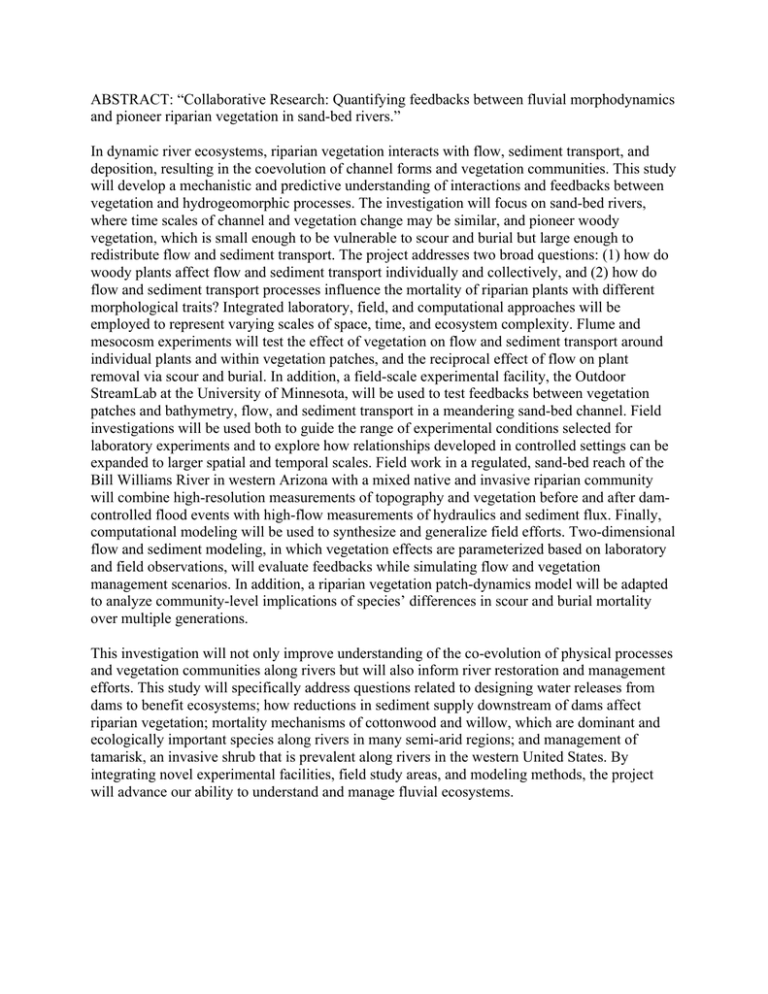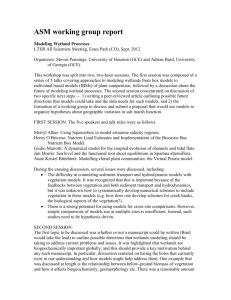ABSTRACT: “Collaborative Research: Quantifying feedbacks between fluvial morphodynamics
advertisement

ABSTRACT: “Collaborative Research: Quantifying feedbacks between fluvial morphodynamics and pioneer riparian vegetation in sand-bed rivers.” In dynamic river ecosystems, riparian vegetation interacts with flow, sediment transport, and deposition, resulting in the coevolution of channel forms and vegetation communities. This study will develop a mechanistic and predictive understanding of interactions and feedbacks between vegetation and hydrogeomorphic processes. The investigation will focus on sand-bed rivers, where time scales of channel and vegetation change may be similar, and pioneer woody vegetation, which is small enough to be vulnerable to scour and burial but large enough to redistribute flow and sediment transport. The project addresses two broad questions: (1) how do woody plants affect flow and sediment transport individually and collectively, and (2) how do flow and sediment transport processes influence the mortality of riparian plants with different morphological traits? Integrated laboratory, field, and computational approaches will be employed to represent varying scales of space, time, and ecosystem complexity. Flume and mesocosm experiments will test the effect of vegetation on flow and sediment transport around individual plants and within vegetation patches, and the reciprocal effect of flow on plant removal via scour and burial. In addition, a field-scale experimental facility, the Outdoor StreamLab at the University of Minnesota, will be used to test feedbacks between vegetation patches and bathymetry, flow, and sediment transport in a meandering sand-bed channel. Field investigations will be used both to guide the range of experimental conditions selected for laboratory experiments and to explore how relationships developed in controlled settings can be expanded to larger spatial and temporal scales. Field work in a regulated, sand-bed reach of the Bill Williams River in western Arizona with a mixed native and invasive riparian community will combine high-resolution measurements of topography and vegetation before and after damcontrolled flood events with high-flow measurements of hydraulics and sediment flux. Finally, computational modeling will be used to synthesize and generalize field efforts. Two-dimensional flow and sediment modeling, in which vegetation effects are parameterized based on laboratory and field observations, will evaluate feedbacks while simulating flow and vegetation management scenarios. In addition, a riparian vegetation patch-dynamics model will be adapted to analyze community-level implications of species’ differences in scour and burial mortality over multiple generations. This investigation will not only improve understanding of the co-evolution of physical processes and vegetation communities along rivers but will also inform river restoration and management efforts. This study will specifically address questions related to designing water releases from dams to benefit ecosystems; how reductions in sediment supply downstream of dams affect riparian vegetation; mortality mechanisms of cottonwood and willow, which are dominant and ecologically important species along rivers in many semi-arid regions; and management of tamarisk, an invasive shrub that is prevalent along rivers in the western United States. By integrating novel experimental facilities, field study areas, and modeling methods, the project will advance our ability to understand and manage fluvial ecosystems.







